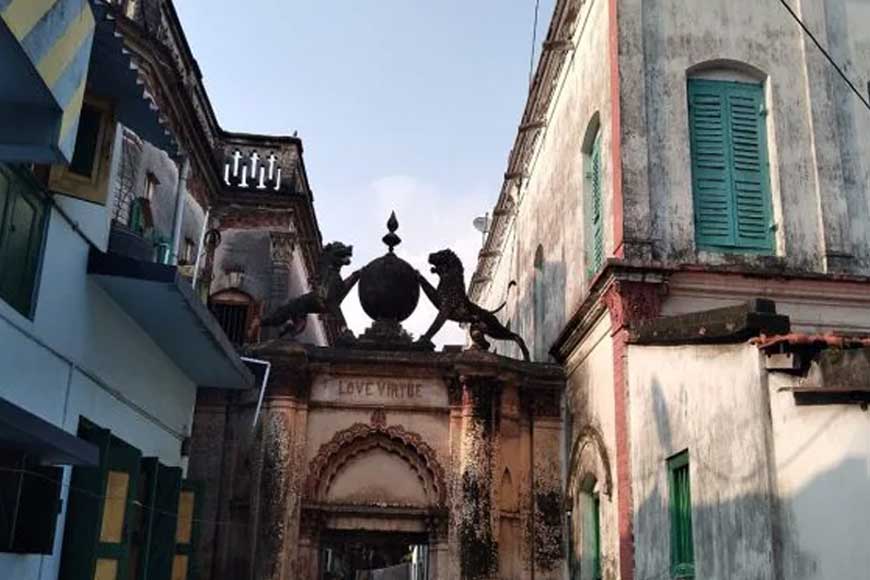Durgapur Aatbari’s complex architecture saved many freedom fighters from arrest

The old palatial houses (Raj-Bari) of erstwhile landlords (zamindars) of Kolkata have long attracted much attention, especially the time-worn icons at Sobhabazaar, Jorasanko and the Marble Palace on Muktaram Babu Street. However, the stately homes of the districts still have surprises in store for the adventure seeking traveller with a nose for historical anecdotes and tales that form an integral part of these majestic, somewhat timeworn buildings.
Nadiha on the outskirts of Durgapur in East Burdwan district is an ancient residential hub and the ancestral abode of the Mukhopadhyay family, the erstwhile zamindars of Nadiha and its adjoining areas. This was long before the industrial city was even conceived. The zamindar of Nadiha built Aaatbari (Eight Houses) for his eight sons who resided in separate houses with their families built in the same compound on a sprawling plot. The Aaatbari house was famous for providing secret shelter to freedom fighters who took up arms against the British Government. As a result, the Nadiha zamindar’s residential complex was always under strict vigil of the British intelligence.
Although not much has been recorded in history about the Nadiha zamindars, the huge, tastefully built but somewhat run-down ancestral mansion stands as a silent witness of its own colourful and glorious past. Durgapur was named after Nadiha’s landlord, Durgacharan Mukhopadhyay. Durgacharan’s sister was married to Taraknath Mukhopadhyay, a resident of Nadiha. Later, eight separate houses (Aatbari) were built within the landlord’s residential complex for the eight sons of Taraknath. The same Aatbari complex later became the hub of revolutionary activities in Bengal.
The Nadiha zamindari (territory held or administered by the Mukhopadhyay family) was under the rule of the Burdwan Royal family. In the pre-Independence days, Durgapur was a dense forested area and an ideal hideout for insurgents who fought against the Raj. They often landed at Aatghar to take refuge and hoodwink the men in mufti. The British force was aware of the Mukhopadhyay family’s involvement in insurgent activities and Taraknath and his sons were often harassed and interrogated on several occasions by high-ranking British officials. But the government could not take any action against them due to lack of concrete evidence. One of the most interesting and striking fact of Aatbari is the complex architectural designs of the houses which provided the perfect hiding locations for the rebels. British soldiers had to exit empty-handed from the complex after every raid as they failed to find any rebel.
Also read : Khejuri Post Office – India’s first post office
Saratchandra Mukhopadhyay, a member of the Nadiha zamindar family, was a distinguished lawyer during the British reign. He was an erudite, honest, fearless man of strict principles who never bowed down before British muscle flexing tactics and remained true to his profession. His house still stands erect in Nadiha as a reminder of the acclaimed lawyer’s abode.
Even after Independence, the Nadiha zamindar family had close connections with notable dignitaries from all spheres of life. Dr Bidhan Chandra Roy, the ‘Maker of Modern Bengal’ was the family physician of the Mukhopadhyays. Dr Roy had close association with the Aatbari Mukhopadhyay family even after he became the Chief Minister of West Bengal. Prime Minister Jawaharlal Nehru and veteran Congressman Prafulla Sen too, were close to the Aatbari Mukhopadhyays.
But times have changed and so has the status of Nadiha Aatbari. Most members of the illustrious family have migrated to different parts of the country or have settled abroad. Many have shifted base to Durgapur or Kolkata. The ancestral house now has a faded look due to lack of maintenance and is gradually ageing and ruining. The safe haven for rebels now stands a hapless victim of the ravages of nature.










